Complete Guide to the Juta Valley Hike Near Kazbegi, Georgia
19 min readOne of a dozen gorges that branch off the Terek River into the mountainous Kazbegi National Park, the Juta Valley (Chaukhi Valley) is among Georgia‘s most popular hiking destinations.
The thing that makes Juta such a spectacular spot is its proximity to Mount Chaukhi – AKA the Georgian Dolomites. This seven-pronged stone massif towers over the valley and provides a fantastic backdrop to a pleasant (at times challenging) day hike, which starts from the iconic Fifth Season cabin (pictured below) and follows the Chaukhistskali River to a waterfall and a small lake.

There are a few things I did not enjoy about visiting Juta – the state of the road, the overtly commercial feel of the village, the lack of infrastructure on the trail, and the fact that there is no grand ‘endpoint’ to the hike other than the artificial lake, which I found a bit disappointing.
But there is no denying that the Juta Valley – with its rolling hills and spring meadows plastered with pink bistorta – is classically beautiful. Or that seeing Chaukhi up close is nothing short of awe-inspiring.
I am very glad I did the hike, and I would not hesitate to recommend it to other travellers who are looking for an entry-level trek in the Kazbegi area.
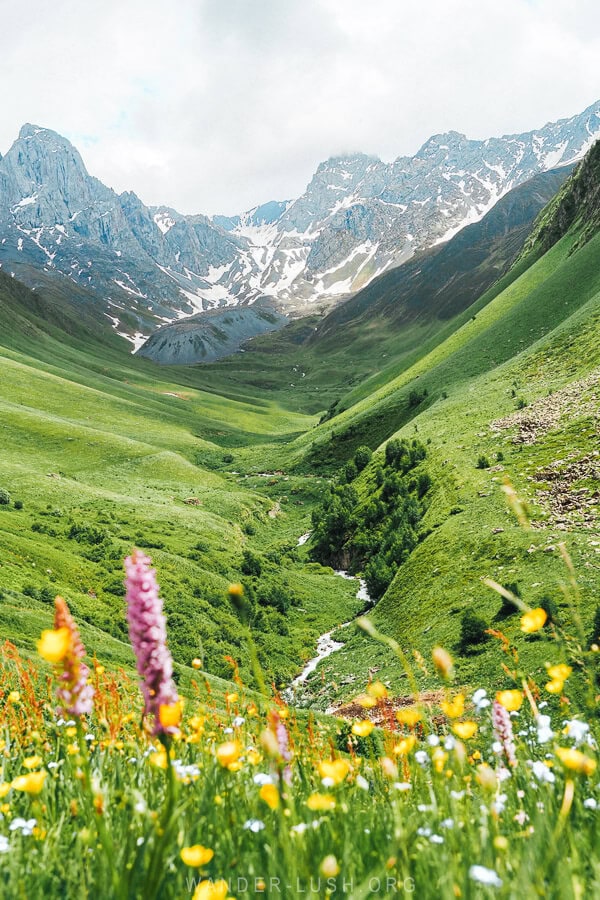
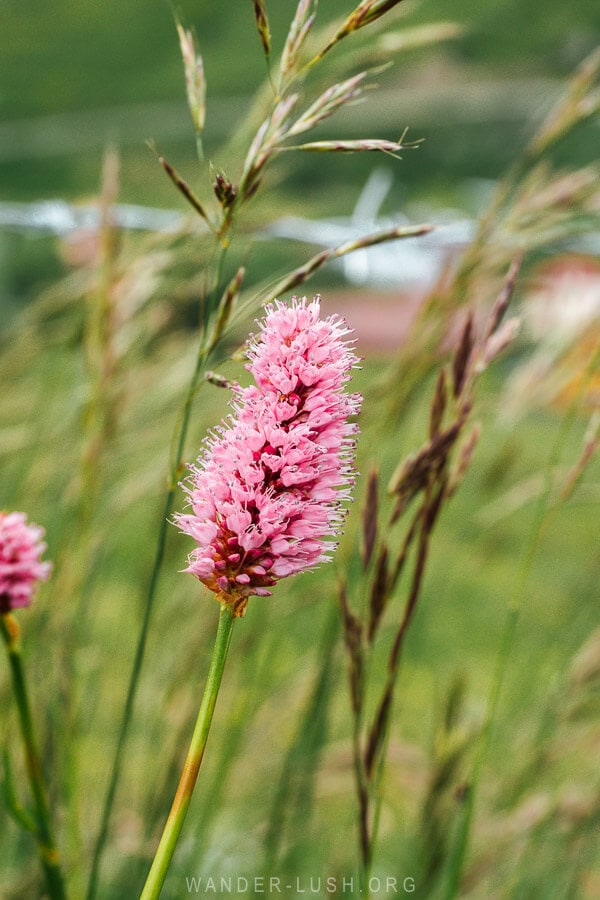
Along with the walk to Gergeti Trinity Church, you can put Juta on your Kazbegi to-do list if you are looking to immerse yourself in the majesty of the Greater Caucasus.
In this guide, I will run through everything you need to know about visiting Juta – including how to get there safely given the current road closure, and what to expect from the hike.
Please note: This post contains affiliate links, meaning I may earn a commission if you make a purchase by clicking a link (at no extra cost to you). Learn more.
What & where is Juta?
Juta is a small village in Kazbegi Municipality, around 20 kilometres (12 miles) from Stepantsminda or 165 kilometres (103 miles) from Tbilisi. It sits on the Jutistskali River amidst the Kazbegi National Park – and as the last village in one of the deepest valleys, it is among the most easterly points in this area that are accessible by road.
Juta is known for its alpine scenery, ferocious river and wildflower meadows. The Chaukhebi Massive (Mount Chaukhi) hangs above the valley and for almost the entirety of the Juta Hike, it is your guiding star. Sometimes referred to as the ‘Georgian Dolomites’, this jagged rock formation reaches 3,842 metres above sea level at its highest point.
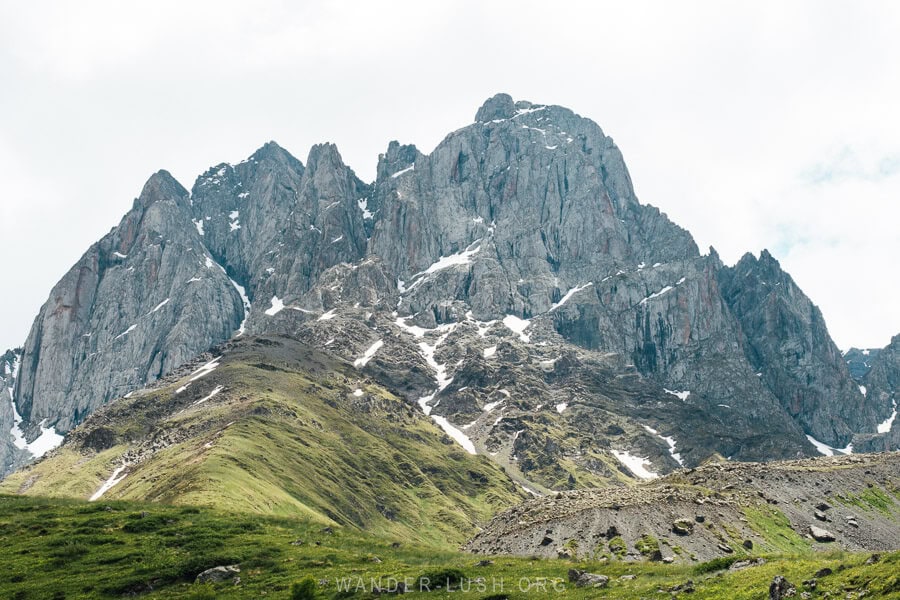
Chaukhi frames Fifth Season, a picture-perfect alpine hut that opened just outside Juta village in 2015. It is one of the most-photographed hotels in Georgia, and it’s fair to say that Fifth Season helped to put Juta on the map. Visitors have the option to spend a night at the cabin, or just drop into the cafe-restaurant for a drink and a bite to eat.
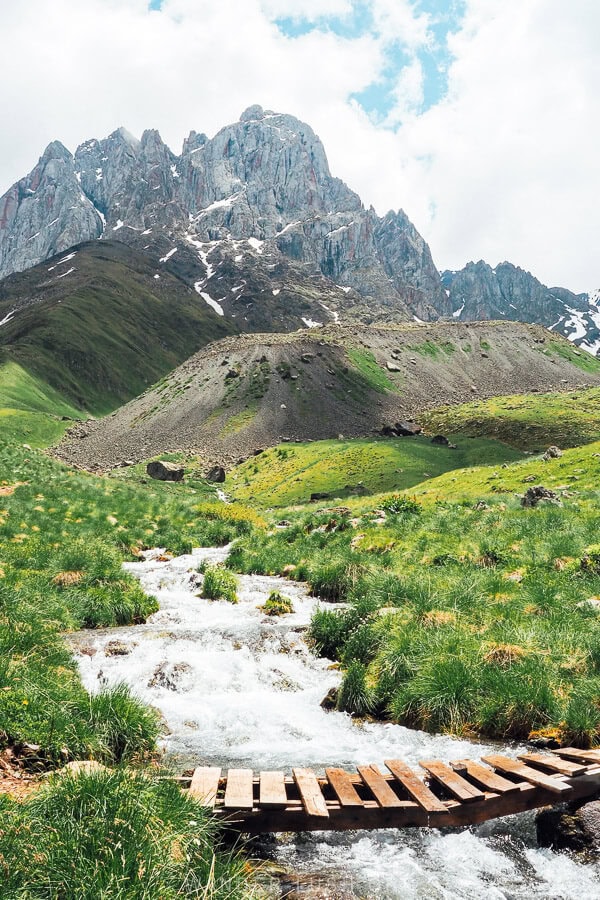
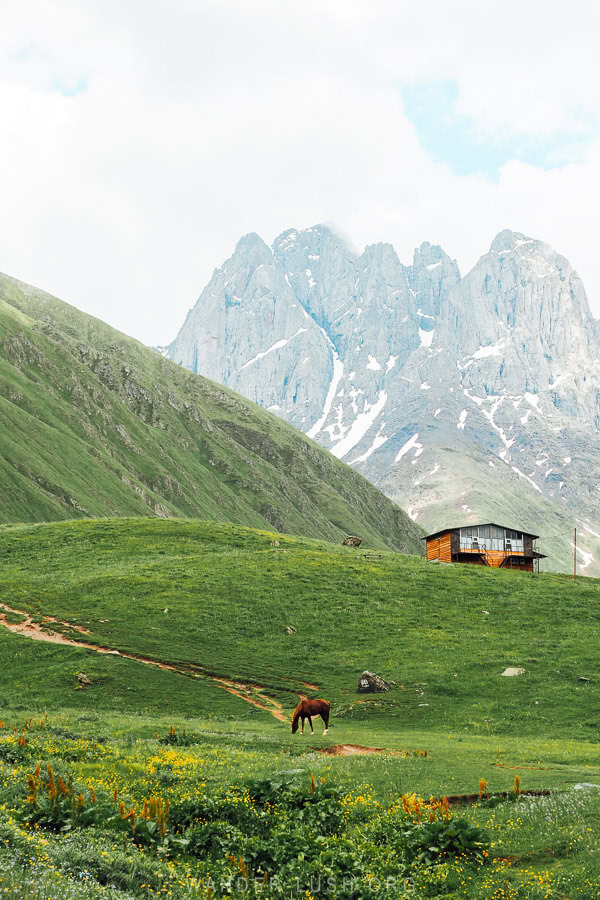
Juta and the Chaukhi Valley is a hike-in destination that you explore on foot. The most popular loop trail starts from the cabin and travels 3 kilometres deeper into the valley – towards the base of Chaukhi Mountain – where there is a waterfall and an artificial lake.
More experienced trekkers can continue along this same trail to cross the Chaukhi Pass and visit the Abudelauri Lakes and the village of Roshka in Khevsureti. This extended hike is best done over two days.
When is the best time to visit Juta?
Juta village is located 2,200 metres above sea level. It is a seasonal destination that is all but inaccessible for part of the year.
The best time to visit Juta is generally considered to be the summer months of July and August, when it is dry and the conditions are most suitable for hiking. The hiking season officially starts in May, and this is when the mountain road into Juta village usually opens to cars. However, spring has been very wet for the past few years and there is an increased likelihood of rain in May and June.
We visited Juta in late June and were treated to verdant green hills and copious amounts of wildflowers. But we also experienced one of the sudden afternoon storms that is common at this time of year.
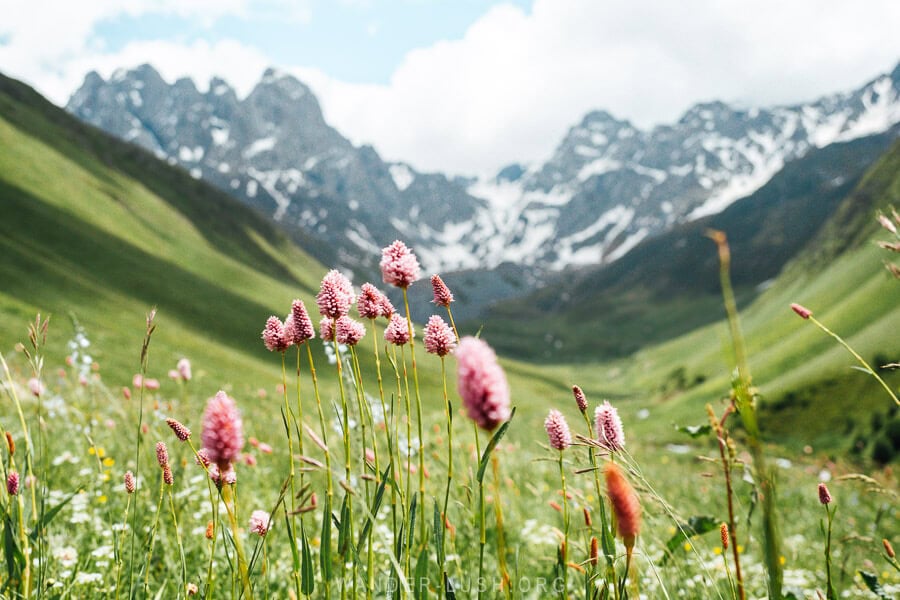
The Juta walk involves several river crossings, and depending on the route you take there might be no bridge. The water level is much higher in spring than in summer, so this is something else to keep in mind.
The autumn months of September-October are ideal if you want to see fall colours – although it will be quite cold by this point so you’ll need proper gear. We are hoping to return to this area this autumn to repeat the hike.
Is Juta safe?
Juta is as safe as any other mountain area in Georgia. It is a very popular destination, and it is set up for tourism. It might be close to the border, but there is no reason to let that dissuade you from visiting. No special permits or permissions are required to visit Juta, and you will not encounter any checkpoints or patrols on the day hike.
I am always worried about encountering shepherd dogs when hiking in Georgia. We didn’t see a single dog in Juta – even when we came across a herd of grazing cows at the beginning of the trail, there was no dog guarding them.
The main safety concern in Juta relates to the road. See below.
Overall you should approach Juta with the same level of common sense caution as you would any other hiking destination. The hike in Juta is marked and straightforward. Solo female hikers are a common sight, and as long as you stick to the path and carry the appropriate gear, the risk is minimal.
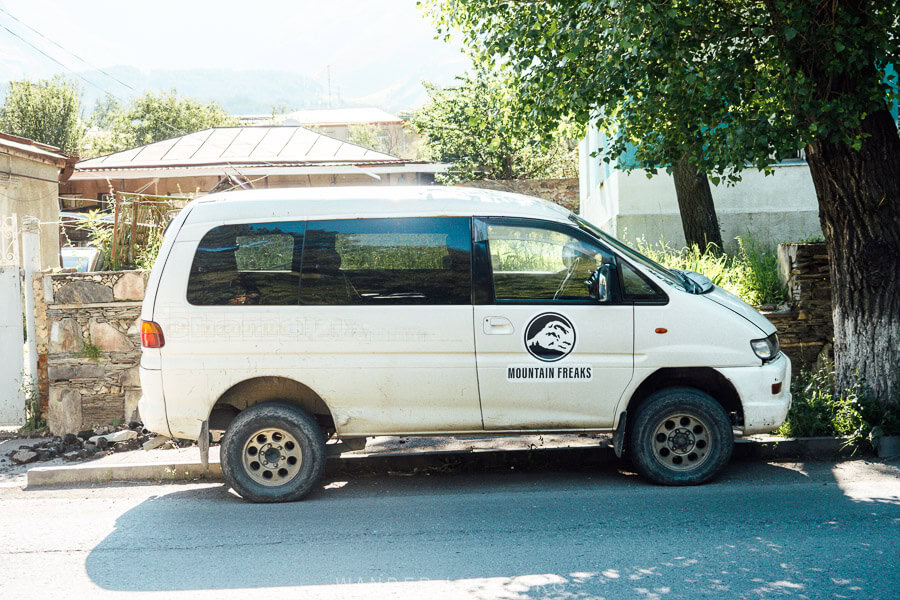
There are two transfers every day between May 1 and October 31, departing from the Mountain Freaks office in the centre of Kazbegi:
- Depart Kazbegi at 9.15am / pick-up in Juta at 5.30pm
- Depart Kazbegi at 11.15 am / pick-up in Juta at 7.30pm
This gives you over 7 hours in Juta, which is ample time to hike to the lake and back, and relax at Fifth Season. The transfer also includes a short 15-minute stop in Sno village for the Giant Stone Heads.
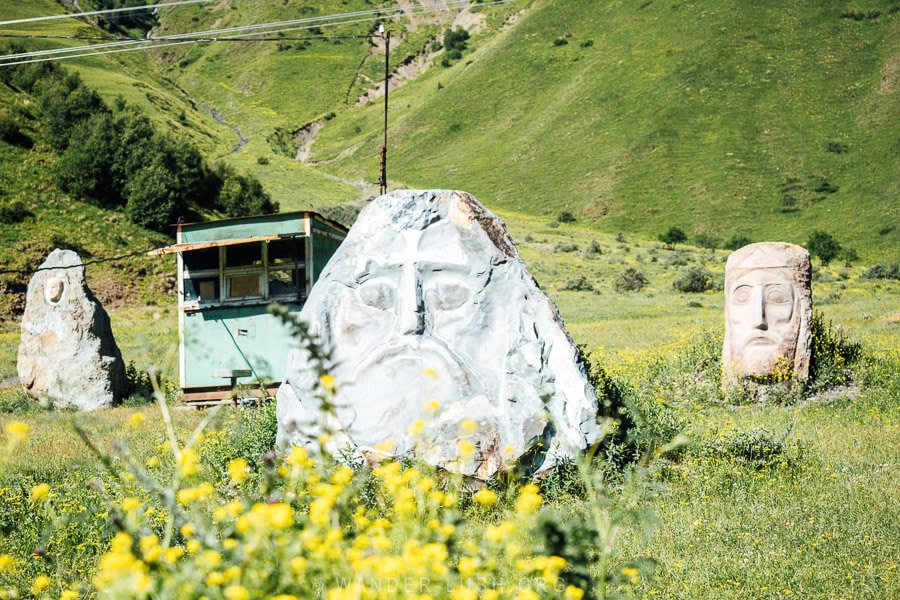
Mountain Freaks uses Delica cars, which only have room for 7 passengers. It is essential to pre-book your spot if you are travelling in the peak season.
Before our trip to Juta, we reserved our places a few weeks in advance through Viator and paid online. Click here to buy a ticket. The price quoted (~18 USD per person) is for a round-trip transfer.
You can also buy tickets for the shared transfer or organise a private transfer in person at the Mountain Freaks office.
If you buy tickets online, remember to arrive at the office a little bit earlier than the scheduled departure time. Staff like to run through the details of the transfer with you in person, and will point out the hiking route and various landmarks on a map. We found this very helpful, and I was generally very impressed with Mountain Freaks’ service.
This company also runs daily transfers to the Truso Valley (for the Truso Valley hike), to the Dariali Gorge north of Kazbegi, and to Gergeti Trinity Church.
Self-driving to Juta
If you have your own car, it is perfectly feasible to drive to the trailhead in Juta from Kazbegi or Tbilisi.
The first part of the drive takes you via the Georgian Military Highway. After the turn-off for Sno, the road turns into an unpaved gravel track. After Karkucha, it starts to get quite steep.
The road is a bit narrow but it is in fairly good condition aside from the final 2.6 kilometres (see note below). A car with high undercarriage clearance is preferable, but a 4WD is not mandatory.
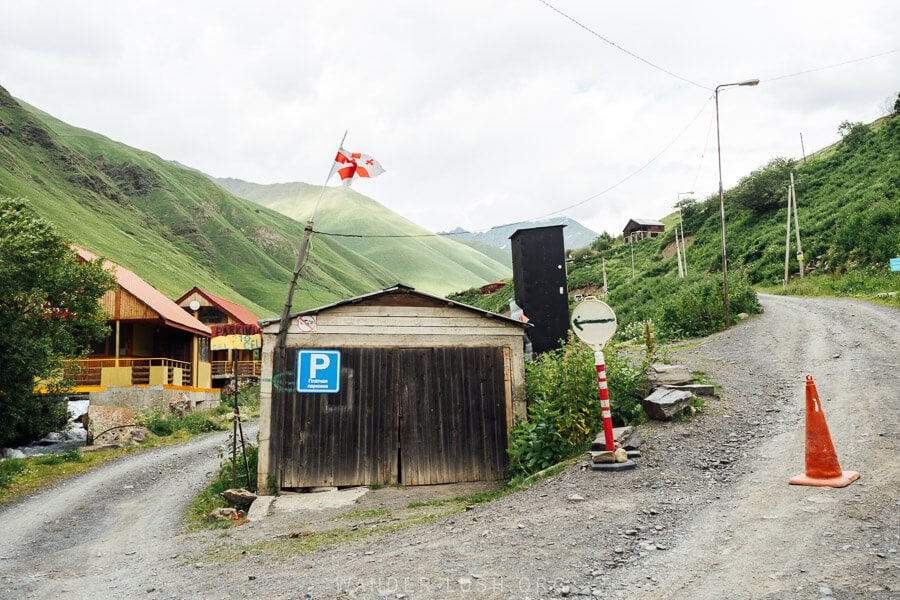
If you decide to drive all the way into Juta village, there is a designated parking area beside the cafe at this location. According to the sign, parking costs 10 GEL per car per day. There are, shall we say, mixed reviews for this parking lot on Google Maps, so do your research. We saw people parking along the road shoulder on the approach to the village.
The road to Juta (and what other blogs don’t tell you)
The last 2.6 kilometres of the mountain road to Juta village is officially closed. This has been the case for at least the past 12 months.
Concerns about this road were first raised in summer 2023, when after heavy rain the road started to subside in some places. (Calling it a ‘road’ is generous – it is an unsealed, narrow gravel track with a sheer drop-off on one side.)
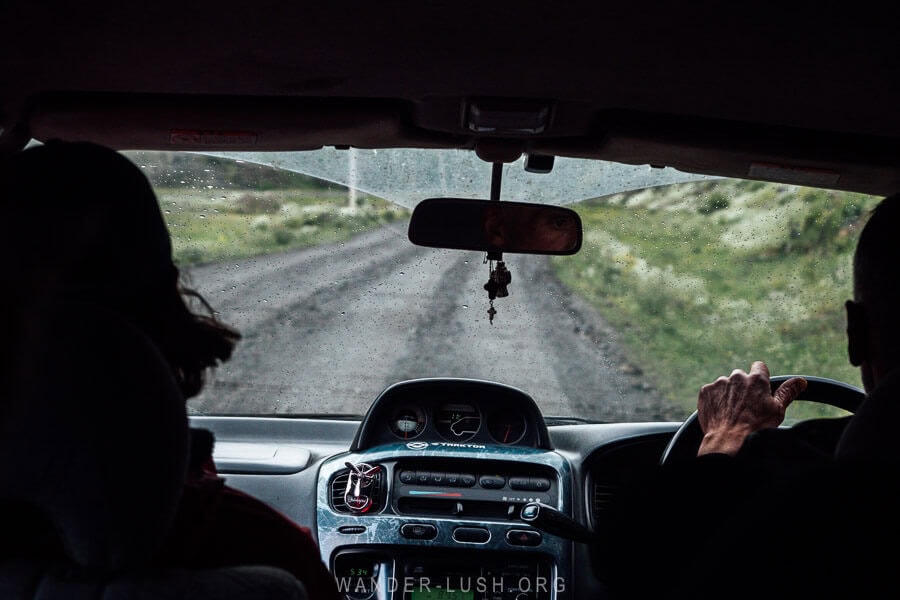
The Juta road is visibly tilting in places, and there are concerns that it is at imminent risk of collapse. There is an urgent need for rehabilitation – but to date, nothing has been done to prop-up the road.
As you approach Juta village, you come to a barricade that has been pushed to one side. At the time of our visit, there were several men around who appeared to be workers. They will not stop you from driving past the closure point – and this is what most cars were doing.
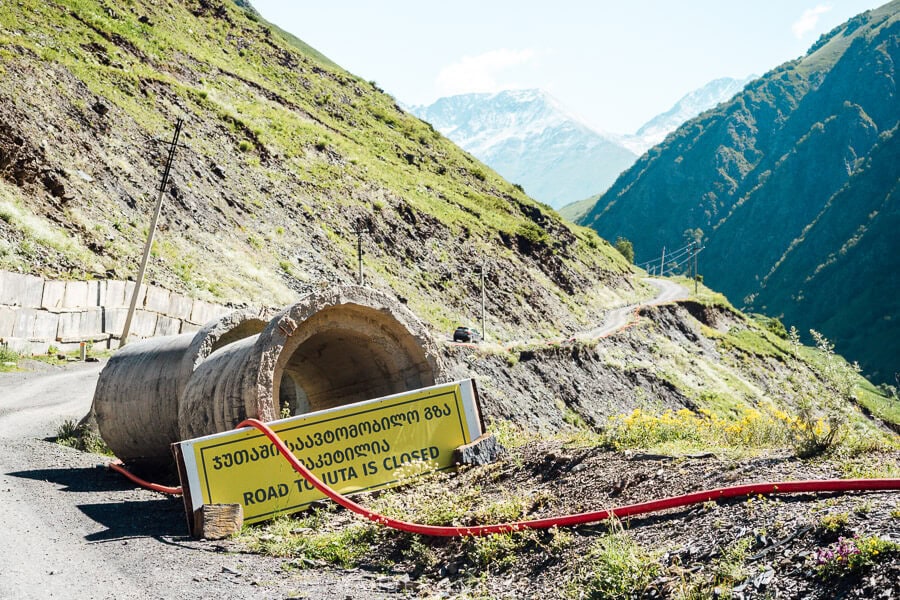
Mountain Freaks has a policy of dropping travellers off at the roadblock. This adds another 5 kilometres of walking (around 90 minutes) to the hike – but I can assure you that you will still have plenty of time to complete the lake route and enjoy Fifth Season.
The extra walk to the village and back is extremely scenic and actually ended up being one of the highlights of the day for me.
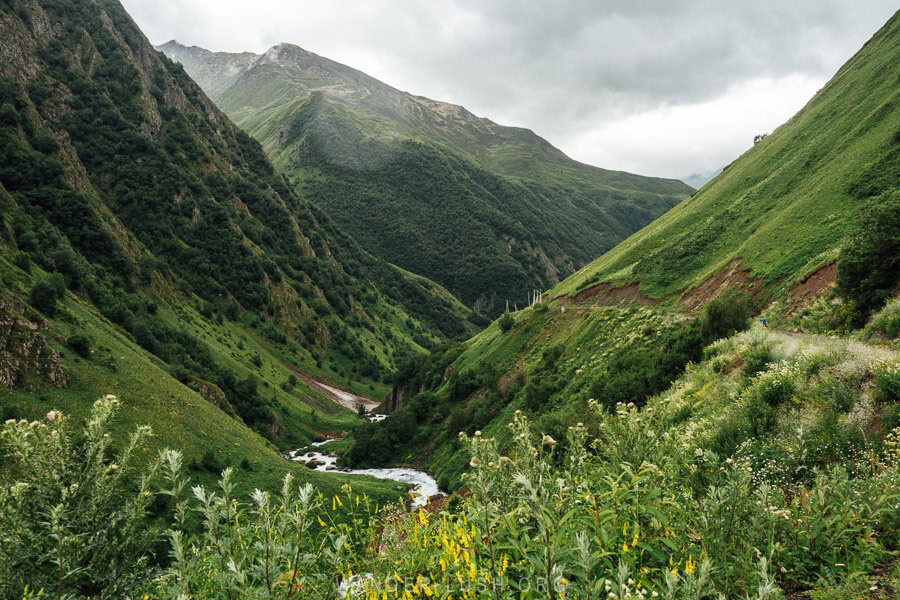
Some travellers have apparently taken issue with this policy, not realising the severity of the road problem, and have been leaving negative reviews on the Mountain Freaks page. As someone who has witnessed way too many road accidents in Georgia, I am a huge supporter of any company that puts safety first.
I am quite cynical about this sort of thing, so I immediately wondered who was profiting off this ‘road closure’. One of the men at the roadblock offered us a taxi the rest of the way to the village, but he almost muttered it under his breath and was not at all pushy.
I don’t know exactly what is going on in Juta, but I do hope that the road is repaired or at least properly closed before there is a serious accident.
Juta hike overview
→ Distance: Approx. 13.2 kilometres (8.2 miles) return loop from the roadblock or approx. 8 kilometres (5 miles) return loop from the village.
→ Time required: 4.5-5 hours return. With photo/rest stops along the way and time at the lake and Fifth Season, I would budget a minimum of 6.5 hours for the hike (if travelling with Mountain Freaks, you get 7.5 hours in Juta).
→ Terrain: Combination of steep rocky track and flat dirt paths. Plus river crossings.
→ Difficulty level: Medium (I struggled with the first part of the walk, which is very steep).
→ Start/end point: Juta village or Juta roadblock (see details on the road closure above).
→ Hiking season: Start of May to end of October.
Preparing for the Juta hike
It is not mandatory to hike in Juta. You can get a great view of Chaukhi Massive and the valley from Fifth Season cabin.
However, the road stops well before Fifth Season, and getting to the cabin does require an uphill walk. I actually found this first part the most challenging: the terrain is very rough, and it’s extremely steep. The only alternative is to hire a horse to carry you and/or your luggage from the village up to the plateau.
I do think it would be a shame to come all this way and not complete the hike. If you’ve made it to Fifth Season, you have already completed the toughest (in my opinion) part. The rest of the hike is relatively flat and pleasant. In the next section, I will describe the route in more detail.
For me, the best parts of this hike were 1) The view from Fifth Season; 2) The approach to Chaukhi from the eastern bank of the river, and 3) The walk along the road from Juta village to the roadblock (details on this below).
How fit do you need to be?
You do need a certain level of fitness for this hike. The steep path up to Fifth Season and the official start point for the trek is hard going. The altitude has an effect, too.
Do you need a guide?
You do not need a guide for this hike. The trail is marked and easy to navigate. If you are visiting in peak period (June to August) there will be plenty of other people on the trail.
There is a phone signal for most of the route, meaning you can use Google Maps to navigate your way to the lake and back (see GPS links in the next section). The hiking trail is plotted on Google Maps – it is not completely accurate, but you can more or less follow it.
My Magti signal did drop out before the waterfall – but by that point, it is obvious where you need to go.
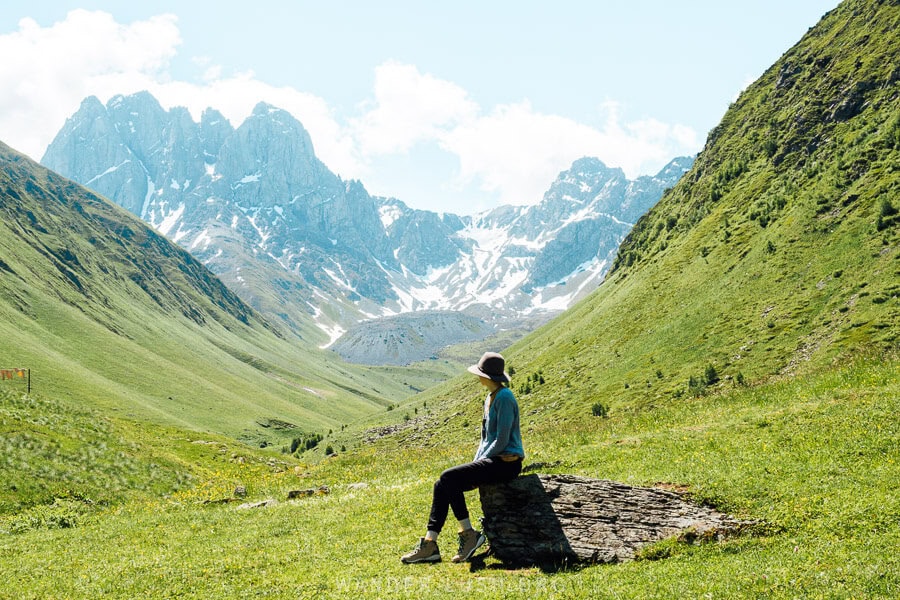
What to wear & bring with you
I decided to wear hiking boots in Juta, and I’m glad I did. Good sneakers might suffice, but something sturdier is recommended. The trail is entirely exposed, so I suggest wearing long sleeves to protect your skin. Bring a light rain/wind jacket. If you have them, trekking poles would be very handy for this hike to help with the uphill and the river crossings.
Bring plenty of drinking water and a snack to enjoy at the lake. Food and water is available to purchase at Fifth Season, and at the cafes in Juta village.
Strategic bathroom breaks
Once you leave the village, your only chance for a bathroom break is at Fifth Season. The Juta trail is very open and exposed, and there is virtually nowhere to ‘be discrete’ – so plan your bathroom breaks accordingly.
Description of the route
This section describes the classic Juta day hike that goes as far as Chaukhi Lake. There are several different ways to do it: We decided to walk on the eastern side of the valley and visit the waterfall first, then we made a loop to return to Fifth Season via the lake and the western side of the river.
The hike can roughly be broken down into six stages:
- From the roadblock to Juta village: 2.6 km; 40 mins
- From Juta village to Fifth Season: 1.1 km; 30 mins
- From Fifth Season to the waterfall: 2.6 km; 75 mins
- From the waterfall to the lake: A few hundred metres; 10 mins
- From the lake back to Fifth Season: 2.7 km; 60 mins
- From Fifth Season back to Juta village & the roadblock: 3.7 km; 60 mins
Stage 1: From the roadblock to Juta village
If you travel with Mountain Freaks, or if you self-drive and decide to play it safe by observing the road closure, then your hike starts here on the Juta road, 2.6 kilometres outside the village.
Obviously you need to walk the rest of the way on the road, which might be somewhat unpleasant if there are a lot of cars going by. We visited after big rain so there was not much dust flying around. As I mentioned, I actually found this part of the walk very scenic and enjoyable.
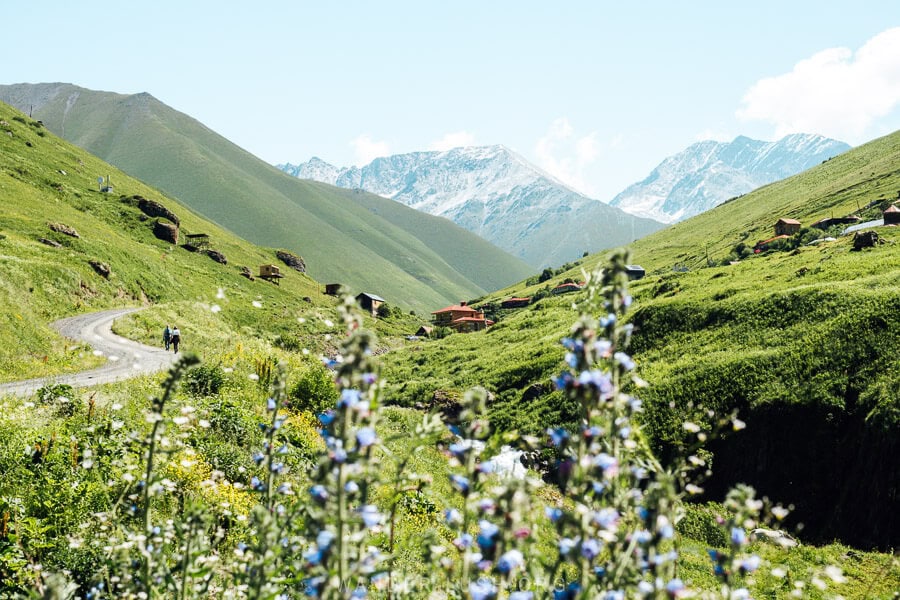
The road is flat with a gradual, creeping incline. The village of Juta appears at roughly the half-way point. As you walk, there is dense forest and a few trickling waterfalls across the valley to see, and there is a spring where you can fill up your water bottle.
After around 40 minutes of walking you will reach the entrance to the village.
Stage 2: From Juta village to Fifth Season
As you enter into Juta, you are met with a collection of buildings that contain guesthouses and cafes. The Jutistskali River (which you have been following up to this point) coalesces with the Chaukhistskhali River, and there is a very pretty scene of a boulder perched in the middle of the rapids with a tiny white cross mounted on top.
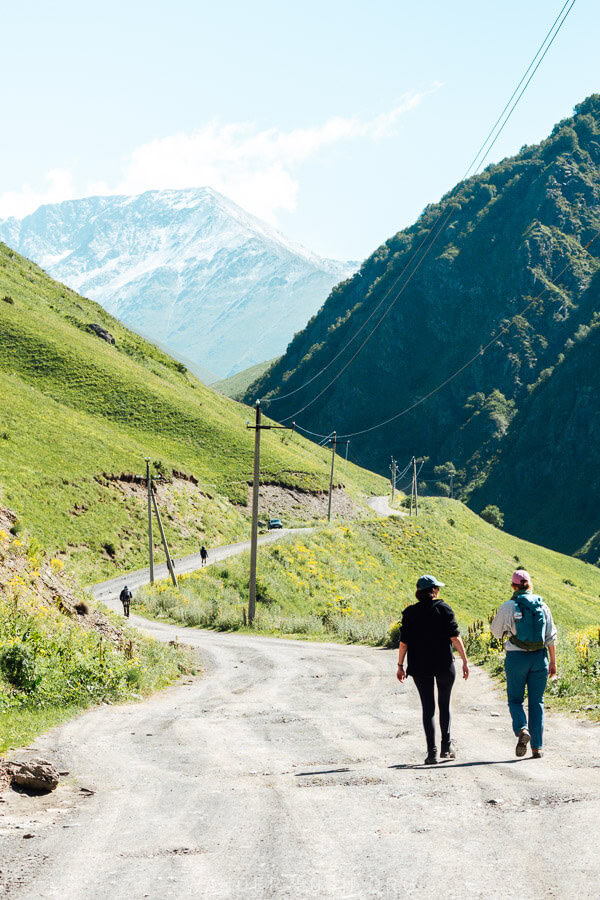
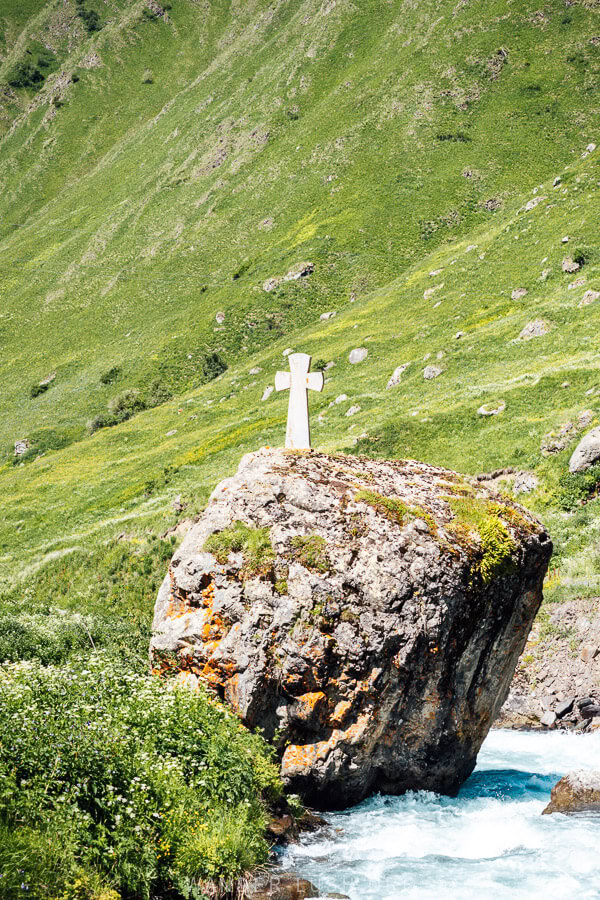
From here, you need to continue straight, past the big cafe building. You will see the marked parking area on your left along with a makeshift roadblock (erected, I think, by the owner of the car park to funnel traffic into his lot).
Just beyond the car park, the road divides: The wider road continues flat, and a narrower gravel track opens up on the hill. You need to take the higher path, following the signs towards Fifth Season.

This path is rough, rocky, and extremely steep. It is only one kilometre to Fifth Season, but this was definitely the hardest part of the walk for me.
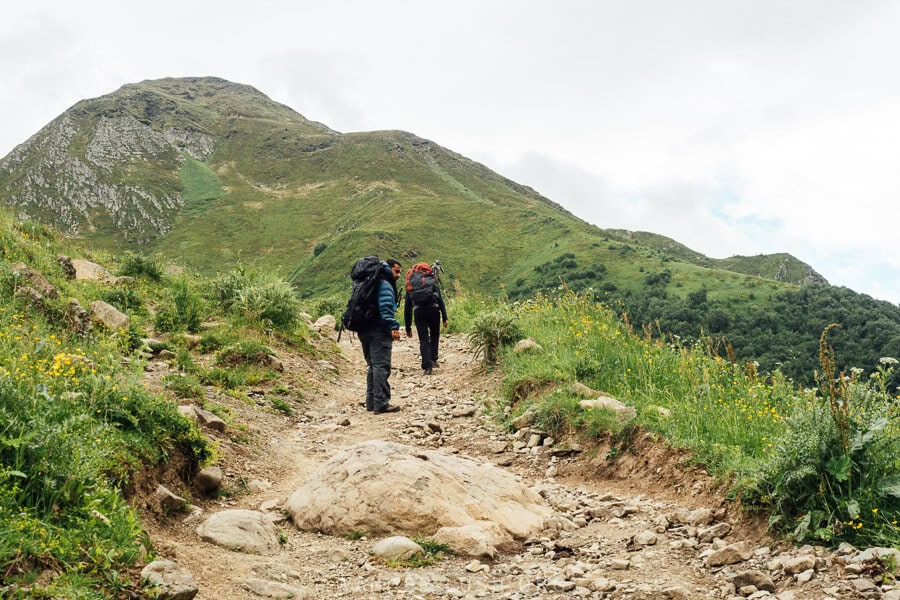
After about 500 metres you will come to the first landmark, Zeta Camping. The path climbs a bit again, and you will see a big boulder painted with a sign for Fifth Season. Keep following the same path to crest the hill, and the cabin will come into view. This is when you get your first glimpse of Mount Chaukhi.
Stage 3: From Fifth Season to the waterfall
We chose to stop at Fifth Season on the way back. If you need a breather at this point (or you want to use the facilities), you can pop into Fifth Season now. If the weather is fine then I do recommend going directly to the lake – it’s scary how fast the weather can change in the mountains, and it’s a good idea to push on if you can.
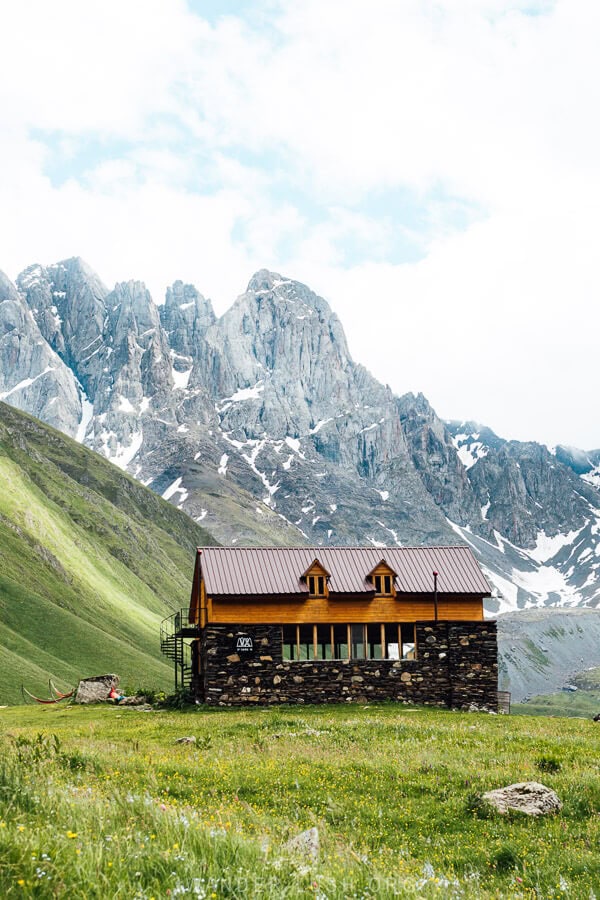

After Fifth Season, the trail is clearly marked and easy to navigate. The landscape here is very open, which makes it easy to identify where you need to go.
In front of Fifth Season there is a way sign pointing towards Chaukhi Lake – your endpoint – which is another 3 kilometres away.
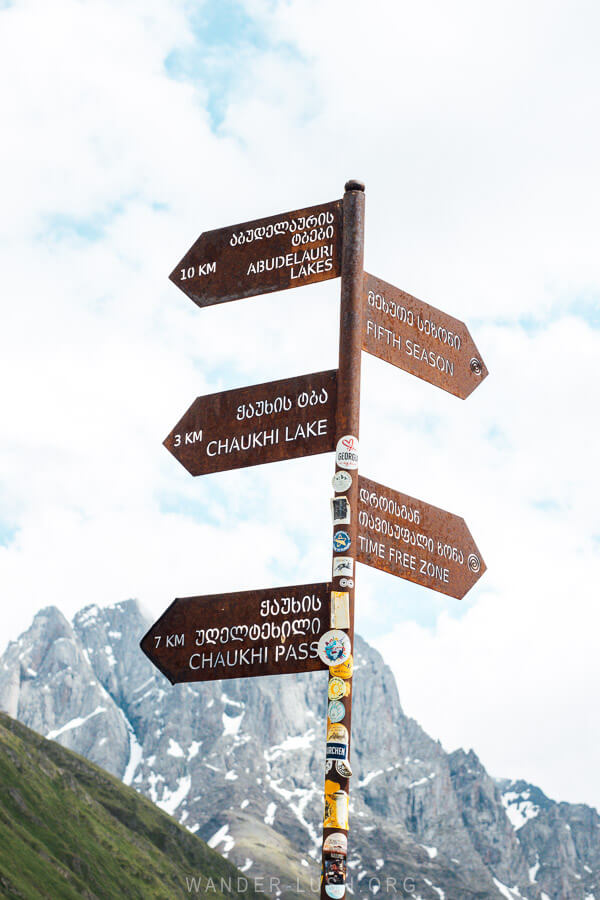
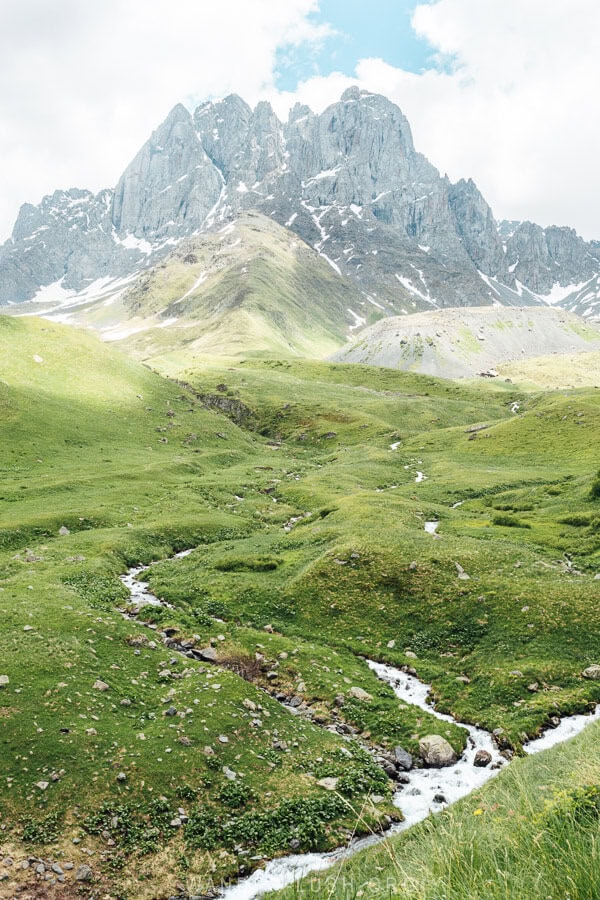
The official trail begins with a bridge crossing. There are meadows on the other side, and you might see an adorable herd of calves canoodling in a bed of wildflowers.
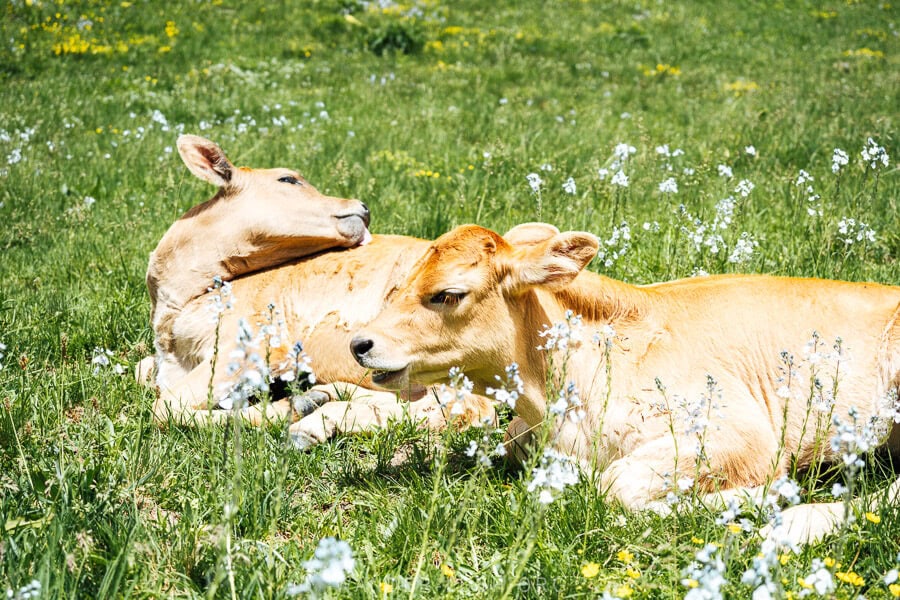
The next part through the valley is self-explanatory. We stuck to the eastern side of the river, which meant we didn’t have to cross the river until right before the lake (more on that in a moment). There are a few places where the path diverges, but if you always stick to the trail that follows the river and looks well-trodden, you can’t go wrong.
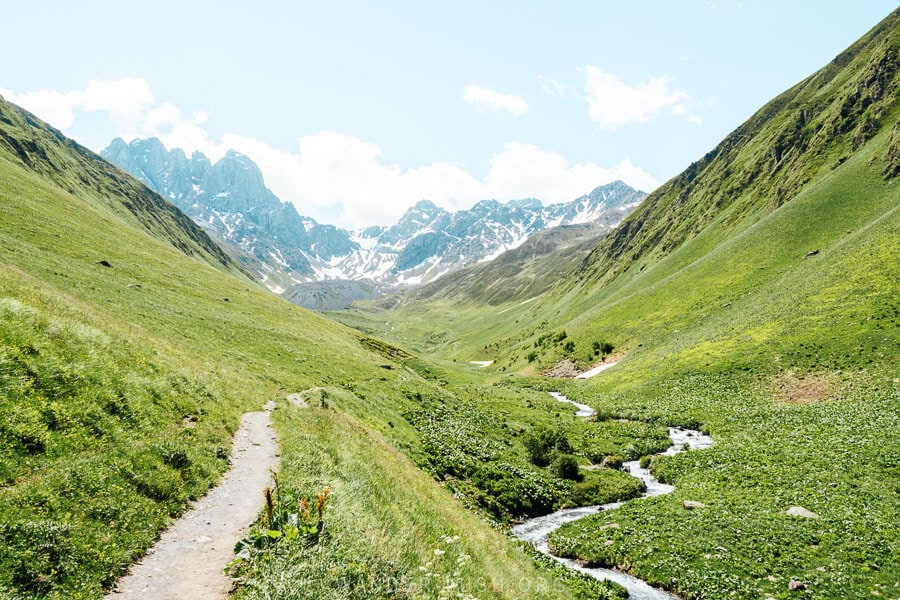
Looking straight down the river valley you will notice a green A-frame cabin in the far distance. You can’t see it yet, but Chaukhi Lake is right next to the cabin. This is your north star to aim towards.
We decided to visit the waterfall first, which is marked on Google Maps more or less correctly at this point (although it is in fact on the eastern side of the river). The trail is mostly elevated above the river, but there are moments where it dips down and you can walk out towards the rocks for a photo.
Just before the waterfall, the view of Chaukhi really opens up and you can start to appreciate the scale of the rock wall.
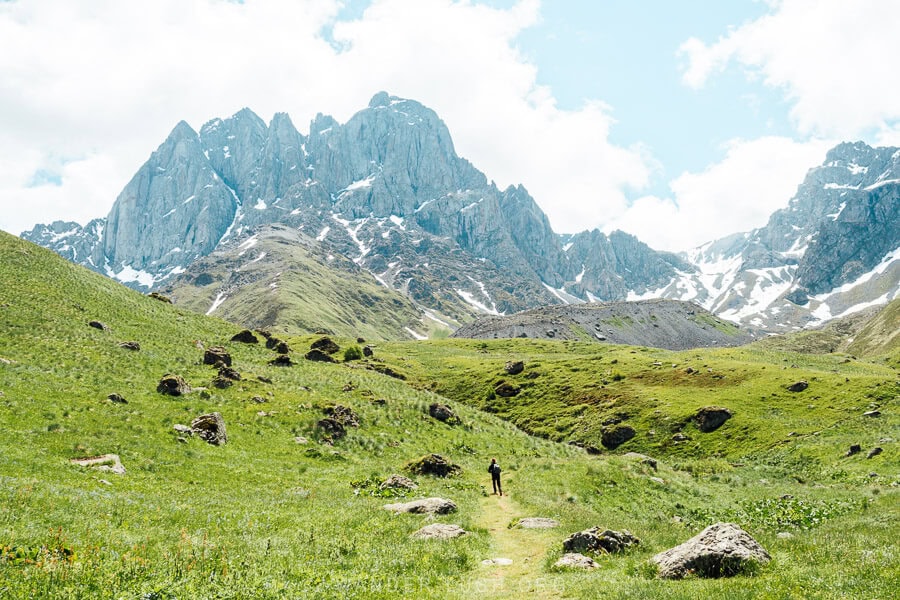
There is a slight uphill at the end to reach the glacial waterfall. It never runs dry, so you will see it even in summer. In June, it was positively ferocious – and a lot more impressive than I was expecting! My photos didn’t really turn out, though.
Stage 4: From the waterfall to the lake
After the waterfall you need to start heading south towards Juta Lake, which is marked here on Google Maps.
First, you will need to cross the waterfall (head slightly downstream where the flow is less intense). It is quite narrow, so this is easy enough to do without getting your feet wet. Use the stepping stones or take a leap of faith across the water.
After crossing, follow the trail straight for a ways and you will eventually come to a small wooden bridge that you can use to cross the river.
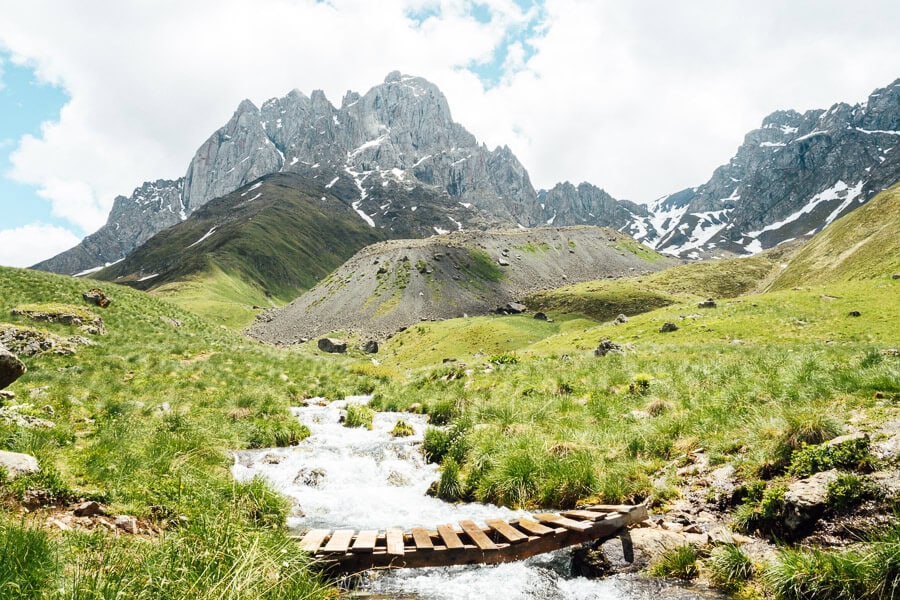
From there, it is just a matter of walking up (via the trail) to the lake. Because the lake is set down in a basin, you don’t see it until you are right up close. That A-frame cabin is apparently a cafe, but it was closed at the time of our visit.
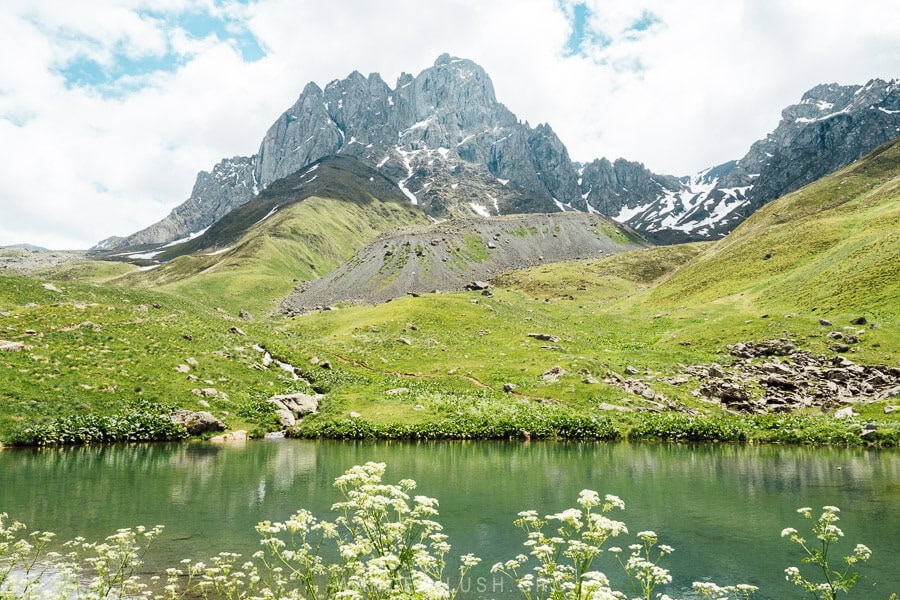
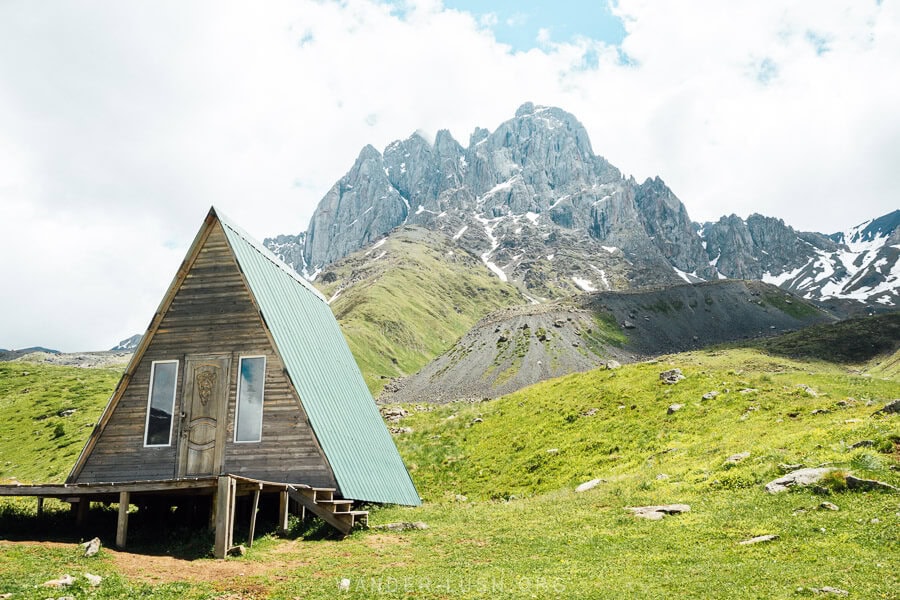
I thought Chaukhi Lake was quite disappointing. It is a small artificial reservoir, and although the view of Chaukhi is nice, the aspect is better on the approach and descent. It’s a shame that there isn’t anything to make the peak of this hike feel ‘special’. It’s all about the journey! We spent a few minutes here before we decided to head back to Fifth Season.
Stage 5: From the lake back to Fifth Season
We opted to walk on the opposite side of the river (i.e. the same side of the river as the lake) to get back to Fifth Season.
This side of the river has more vegetation. The perspective on Chaukhi is incredible, so don’t forget to look back over your shoulder as you make your way downhill.
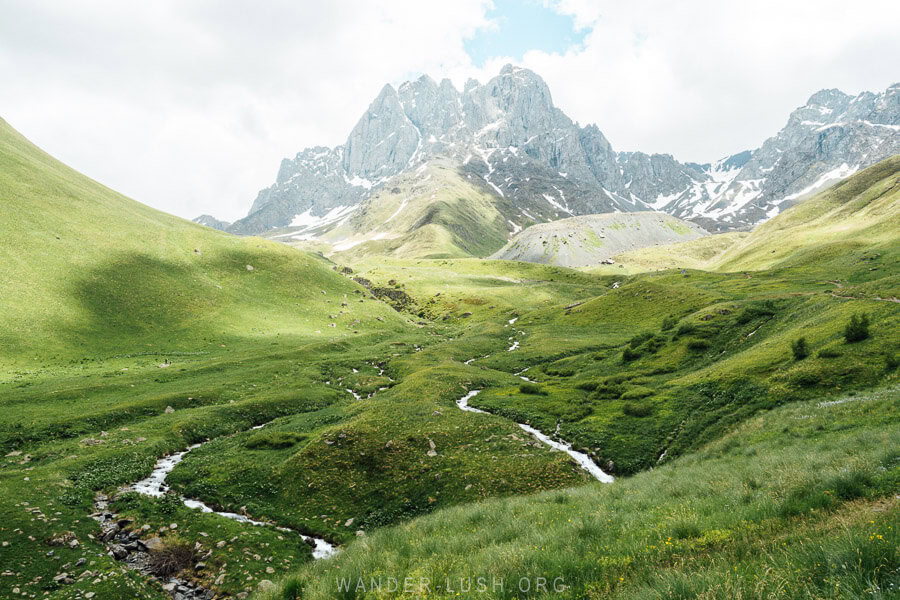
At some point this path intersects with the river to take you back to the eastern side of the valley and the path you walked up on. In May and early June, there is a hunk of ice that you can traverse to cross – but it was partially melted by the time we got there, and we decided that it looked unstable. In the absence of a bridge, your only option here is to ford the river.

We searched for a good spot but couldn’t see anything obvious. In the end, we backtracked and followed another couple who looked like they actually knew what they were doing. In June, the river was quite wide – at least six or seven steps – calf-deep, and fast-moving. There were no strategically placed stepping stones this time, so we had to remove our shoes and wade across.
I have never felt water so cold. There was a point where I felt like I actually couldn’t go on! The last two or three steps were agony.
When we explored the other side of Chaukhi by hiking to the Abudelauri Lakes a few days later, we encountered beautiful new bridges. I do hope similar infrastructure is created in Juta because for anyone like me who is not used to hiking, the river crossings are really a test.
You can avoid having to ford the river by returning the same way you came via the waterfall and using the wooden bridge.
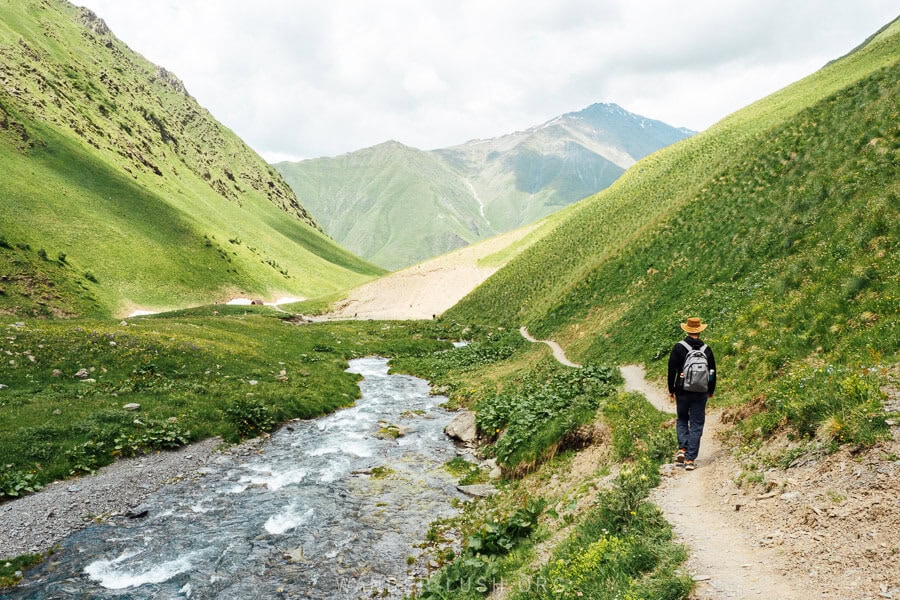
We made it back to Fifth Season at 2.15pm, 3 hours and 45 minutes after we left the village. This gave us ample time to relax before we had to walk back to the roadblock for our 5.30pm pickup.
Stage 6: From Fifth Season back to Juta village & the roadblock
After the exhilarating river crossing experience, all I could think about was a warm cup of coffee and a slice of khachapuri. Unfortunately for us, the power was out at Fifth Season so they could only manage a bottle of Borjomi mineral water.
We spent about 30 minutes walking around the grounds at Fifth Season. There is a beautiful view of the valley looking towards Chaukhi from the outdoor seating area.
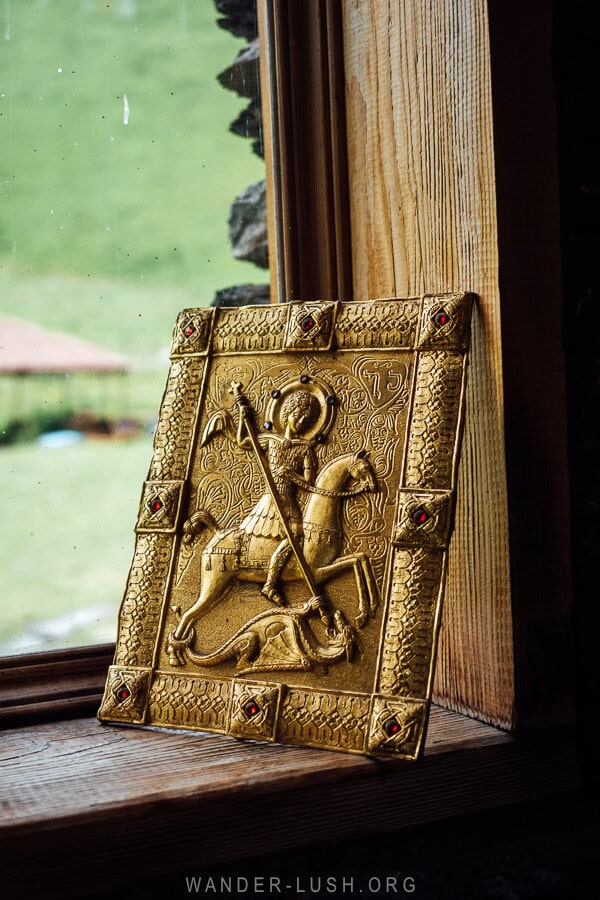
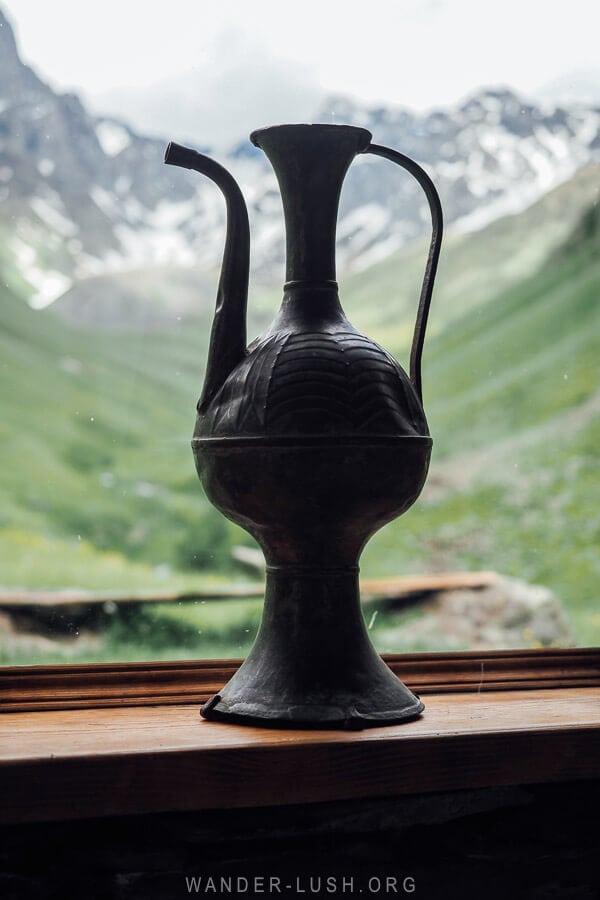
The way back from Fifth Season via that same steep dirt path is a lot easier when you’re going down, but there were several points where I almost slipped over. I can imagine that it would be really tough going if it’s muddy and wet.
Back in the village, we stopped for a coffee at the big cafe next to the carpark. Prices here are surprisingly reasonable. Right on cue, the heavens opened and we were feeling very chuffed with ourselves for timing the hike perfectly.
We gave ourselves an hour to get back to the pickup point at the roadblock. With stormclouds overhead, the light was totally different on the way back and the views of the gorge from the road even more beautiful.
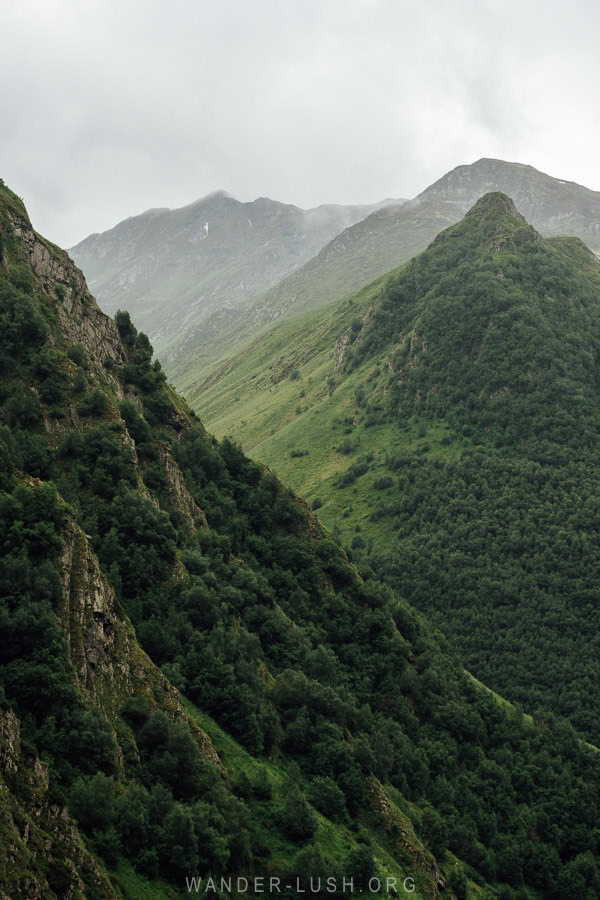
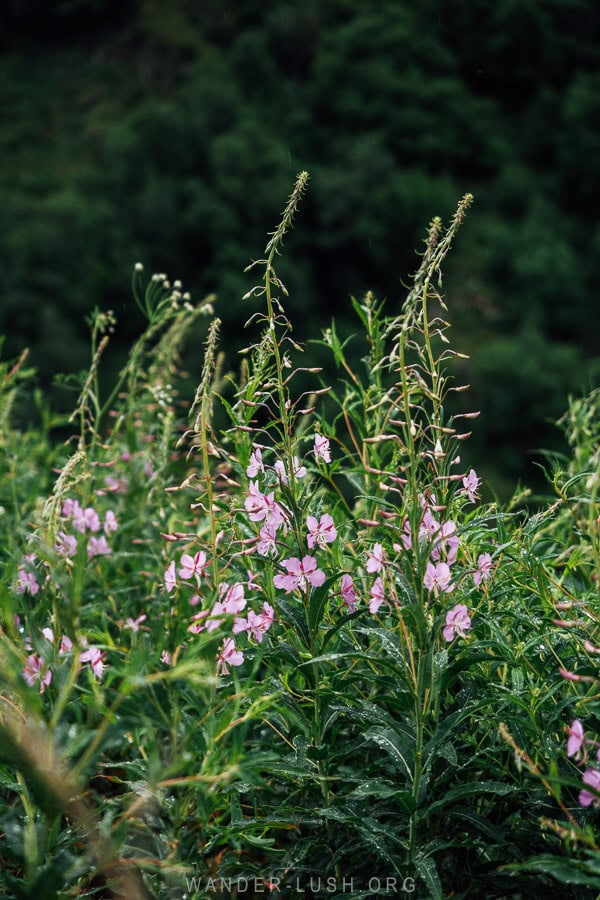
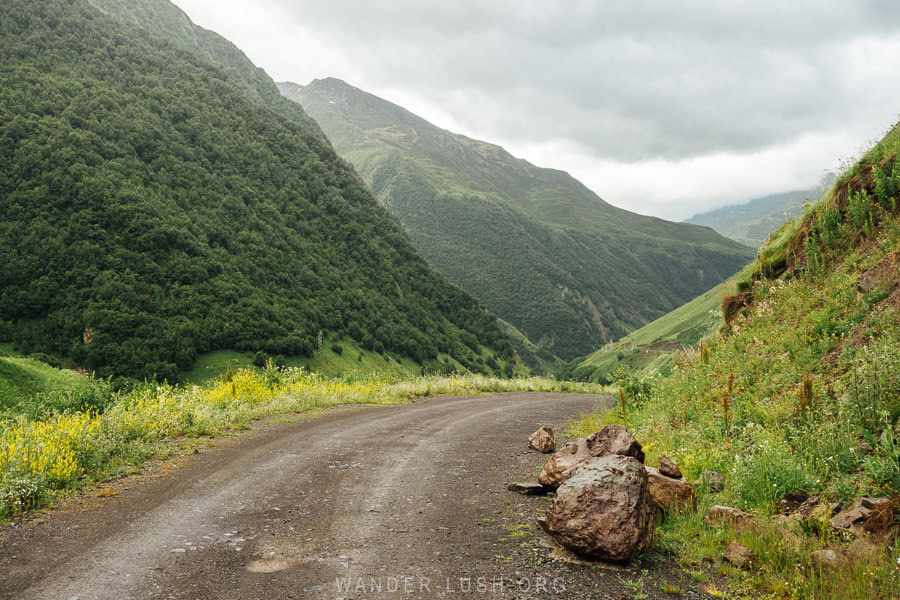
Thankfully everyone else in our group was ahead of us, so we could depart on schedule (the driver will only wait 5 minutes for stragglers, so be sure to arrive on time).
Drop-off in Kazbegi is at the Mountain Freaks office where you started. If you’re hungry, I recommend going for a meal at Qondari, one of my favourite restaurants in Kazbegi that is just a few doors down.
Extending the hike to the Chaukhi Pass, Abudelauri Lakes & Roshka
There is a version of this hike that stretches over two days and takes you all the way into Khevsureti via the Chaukhi Pass and the Abudelauri Lakes. We knew we would be hiking to the colourful lakes from Roshka a few days later (and let’s be honest, there is no way I am fit enough for a multi-day hike!) so we were more than satisfied with the day trek option.
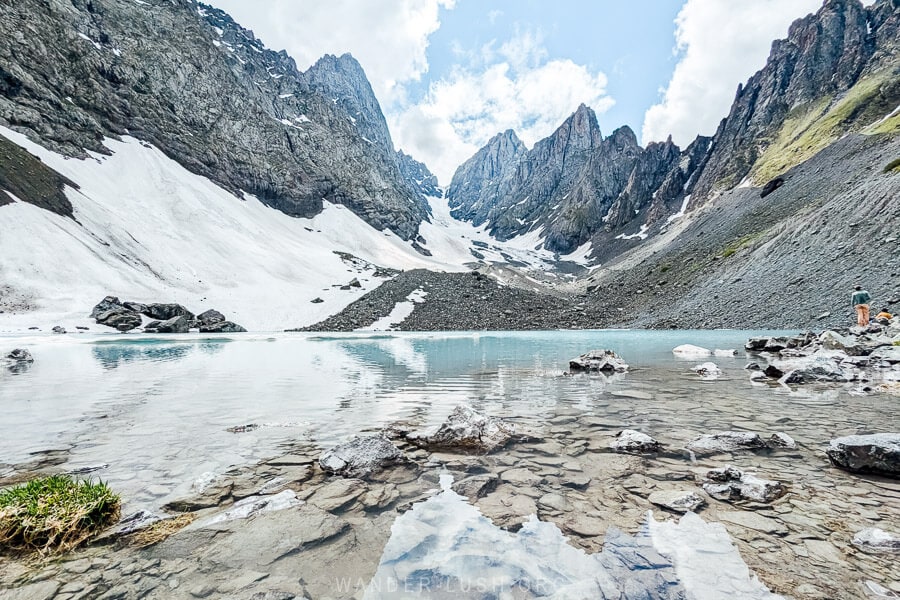
If you are very fit and speedy, you might have time to reach the pass and make it back in time for the return transfer with Mountain Freaks. But there is no way you could reach the Abudelauri Lakes.
If you’re interested in hiking all the way to Roshka, here is a full guide to the trek. Marked campsites are available enroute. Mountain Freaks gives you the option to do a one-way transfer to Juta – the price is the same, and you will need to inform staff so they know not to wait for you.
Map of the Juta hike
Please note that this is NOT a trail map you should use for navigation – it is just a simple map of the Juta area and major landmarks designed to give you a rough lay of the land and an idea of where the trail leads.
Where to stay in Juta
If you want to overnight in Juta then Fifth Season is the obvious choice. I felt satisfied having spent an hour or so at the cafe – but waking up here must be something special and it’s definitely something I want to do in the future.
An alternative is Zeta Camping (also on the plateau). It doesn’t have the same views, but it does appear to have good facilities (and a lower price point).
There are several simple family guesthouses in Juta village. Of these, Levan & Meggie’s Guesthouse and Hotel Shibi have the best reviews.



